Greer Garson
 From Nwe
From Nwe
| Greer Garson | |
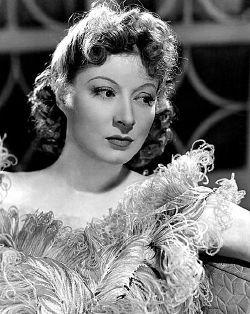
Publicity photo of Garson c. 1940s
|
|
| Born | Eileen Evelyn Greer Garson September 29 1904 Manor Park, East Ham, Essex, England |
|---|---|
| Died | April 6 1996 (aged 91) Dallas, Texas, U.S. |
| Resting place | Sparkman-Hillcrest Memorial Park Cemetery |
| Citizenship | United Kingdom (1904–1996) United States (1951–1996) |
| Alma mater | King's College London University of Grenoble |
| Occupation | Actress, singer, philanthropist |
| Political party | Republican |
| Spouse(s) | Edward Snelson (m. 1933; div. 1943) Richard Ney (m. 1949; died 1987) |
Eileen Evelyn Greer Garson CBE (September 29, 1904 – April 6, 1996) was a British-American actress and singer. She was a major star at Metro-Goldwyn-Mayer who became popular during the Second World War for her portrayal of strong women on the homefront, inspiring the public in both Britain and America during the challenging years of the war.
Garson received seven Academy Award nominations, including a record-tying (with Bette Davis) five consecutive nominations (1941–1945) in the actress category, winning for her performance in the title role of the 1942 film Mrs. Miniver. Although her popularity waned with the conclusion of the war, she continued to act on stage, radio, and television as well as the big screen, providing enjoyable and uplifting entertainment to the public. Recognition for her contributions to society through her acting continued almost to the end of her life: Her final Academy Award nomination was for her portrayal of Eleanor Roosevelt in the 1960 movie Sunrise at Campobello, and in 1993 Queen Elizabeth II recognized Garson's achievements by investing her as Commander of the Order of the British Empire (CBE).
Life
Greer Garson was born on September 29, 1904[1] in Manor Park, East Ham (then in Essex, now part of London), the only child of Nancy Sophia "Nina" (née Greer; 1880-1958) and George Garson (1865–1906), a commercial clerk in a London importing business. Her father was born in London to Scottish parents, and her mother was born at Drumalore (usually spelled as Drumalure or Drumaloor), a townland near Belturbet in County Cavan, Ireland. The name Greer is a contraction of MacGregor, another family name.[1]
Her maternal grandfather David Greer (c. 1848-1913 from Kilrea, County Londonderry), was an RIC sergeant stationed in Castlewellan, County Down. In the 1870s or 1880s he became a land steward to the wealthy Annesley family, who built the town of Castlewellan. While there, he lived in a large detached house called "Clairemount", which was built on the lower part of what was known as Pig Street, or locally known as the Back Way, near Shilliday's builder's yard. It was often erroneously reported Greer Garson was born there (The Macmillan International Film Encyclopedia gives her place of birth as County Down, and year of birth as 1908).[2]
Garson read French and eighteenth-century literature at King's College London and did her postgraduate studies at the University of Grenoble. While aspiring to be an actress, she was appointed head of the research library of LINTAS in the marketing department of Lever Brothers. Her co-worker there, George Sanders, wrote in his autobiography that it was Garson who suggested he take up a career in acting.[3]
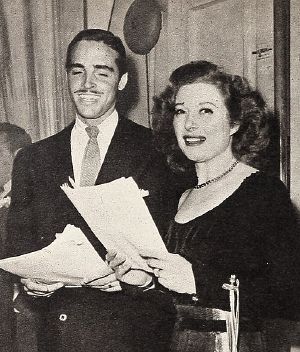
Garson was married three times. Her first marriage, on 28 September 1933, was to Edward Alec Abbot Snelson (1904–1992), later Sir Edward, a British civil servant who became a noted judge and expert in Indian affairs. After a honeymoon in Germany, he returned to his appointment at Nagpur, a town in central India, and she chose to return to her mother and the theatre in Britain.[1] Snelson reportedly grieved at losing her and would watch multiple screenings of any film of hers that played in Nagpur. The marriage was not formally dissolved until 1943.
Her second marriage, on July 24, 1943, was to Richard Ney (1916–2004), a young actor who had played her son in Mrs. Miniver. The relationship was under constant scrutiny owing to their 12-year age difference. MGM claimed that Garson was merely three years older than Ney and tried to portray them as a happy couple, but the marriage was troubled. They divorced in 1947, after several attempts at reconciliation.[4]
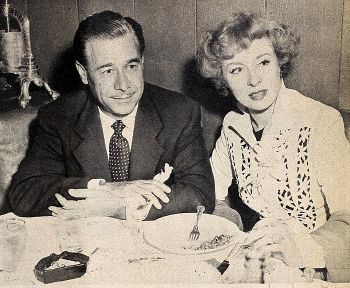
Her third marriage in 1949, was to millionaire Texas oilman and horse breeder, E.E. "Buddy" Fogelson (1900–1987). This marriage was successful, lasting until his death in 1987. In 1967, the couple retired to their Forked Lightning Ranch in New Mexico. They purchased the US Hall of Fame champion Thoroughbred Ack Ack from the estate of Harry F. Guggenheim in 1971,[5] and were successful as breeders.[6] They also maintained a home in Dallas, where Garson funded the Greer Garson Theatre facility at Southern Methodist University.[7] She founded a permanent endowment for the Fogelson Honors Forum at Texas Christian University (TCU), Buddy Fogelson's alma mater, in nearby Fort Worth.[6]
In 1951, Garson became a dual citizen of the United Kingdom and the United States. She was a registered Republican and in 1966 was asked to run for Congress on the Republican ticket against Democrat Earle Cabell but declined.[8]
During her later years, Garson was recognized for her philanthropy and civic leadership. She donated several million dollars for the construction of the Greer Garson Theatre at both the Santa Fe University of Art and Design and at Southern Methodist University's Meadows School of the Arts on three conditions: 1) the stages be circular, 2) the premiere production be A Midsummer Night's Dream, and 3) they have large ladies' rooms.[9]
Garson was a devout Presbyterian.[1] She lived her final years in a penthouse suite at the Presbyterian Hospital of Dallas, where she died from heart failure on 6 April 1996, at the age of 91.[10] She is interred beside her husband in the Sparkman-Hillcrest Memorial Park Cemetery in Dallas.[11]
Career
Garson's early professional appearances were on stage, starting at Birmingham Repertory Theatre in January 1932, when she was 27 years old. She appeared on television during its earliest years (the late 1930s), most notably starring in a 30-minute production of an excerpt of Twelfth Night in May 1937, with Dorothy Black. These live transmissions were part of the BBC's experimental service from Alexandra Palace, and this is the first known instance of a Shakespeare play performed on television.[1] In 1936, she appeared in the West End in Charles Bennett's play Page From a Diary, and Noël Coward's play Mademoiselle.
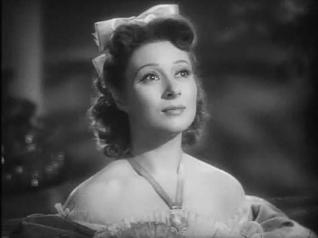
Louis B. Mayer discovered Garson while he was in London looking for new talent. Garson was signed to a contract with MGM in late 1937. The actress suffered a back injury during her first 18 months at MGM while waiting for a role Mayer deemed worthy of her, and was nearly released from her contract.
She began work on her first film, Goodbye, Mr. Chips, in late 1938. She received her first Oscar nomination for the role, but lost to Vivien Leigh for Gone with the Wind. She received critical acclaim the next year for her role as Elizabeth Bennet in the 1940 film Pride and Prejudice.[12]
Garson starred with Joan Crawford in When Ladies Meet, a 1941 poorly received and sanitized re-make of a pre-Code 1933 film of the same name, which had starred Ann Harding and Myrna Loy. That same year, she became a major box-office star with the sentimental Technicolor drama Blossoms in the Dust, which brought her the first of five consecutive Best Actress Oscar nominations, tying Bette Davis's 1938–1942 record, which still stands.[13]

Garson starred in two Academy Award-nominated films in 1942, Mrs. Miniver and Random Harvest. She won the Academy Award for Best Actress for her performance as a strong British wife and mother protecting the homefront during the Second World War in Mrs. Miniver, co-starring Walter Pidgeon.[14] The Guinness Book of World Records credits her with the longest Oscar acceptance speech, at five minutes and 30 seconds,[15] after which the Academy Awards instituted a time limit.
In Random Harvest, she co-starred with Ronald Colman. The drama received seven Academy Award nominations, including Colman for Best Actor and Best Picture, but Garson was ineligible, as she had already been nominated that year for Mrs. Miniver. The American Film Institute ranked it #36 on its list of 100 Greatest Love Stories of All Time, and it was one of Garson's favorite films.[16]
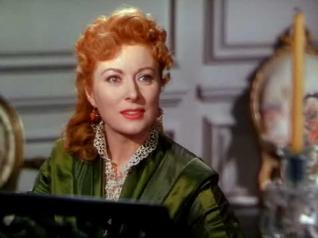
Garson also received Oscar nominations for her performances in the films Madame Curie (1943), Mrs. Parkington (1944), and The Valley of Decision (1945). She frequently co-starred with Walter Pidgeon, ultimately making eight pictures with him: Blossoms in the Dust (1941), Mrs. Miniver (1942), Madame Curie, Mrs. Parkington, Julia Misbehaves (1948), That Forsyte Woman (1949), The Miniver Story (1950), and Scandal at Scourie (1953).
Garson was partnered with Clark Gable, after his return from war service, in Adventure (1945). The film was advertised with the catch-phrase "Gable's back, and Garson's got him!"[17]
She injured her back again while filming Desire Me in Monterey on April 26, 1946 when a wave knocked her and co-star Richard Hart from the rocks where they were rehearsing. A local fisherman and a film extra rescued Garson from the surf and potential undertow. She was bruised and in shock and required by doctors to rest for several days. The injury to her back would require several surgeries over the coming years.[1]
Garson's popularity declined somewhat in the late 1940s, but she remained a prominent film star until the mid-1950s. In 1951, she became a naturalized citizen of the United States.[1] She made only a few films after her MGM contract expired in 1954. In 1958, she received a warm reception on Broadway in Auntie Mame, replacing Rosalind Russell, who had gone to Hollywood to make the film version. In 1960, Garson received her seventh and final Oscar nomination for Sunrise at Campobello, playing Eleanor Roosevelt, this time losing to Elizabeth Taylor for BUtterfield 8.
Greer was a special guest on an episode of the TV series Father Knows Best, playing herself. On October 4, 1956, Garson appeared with Reginald Gardiner as the first two guest stars of the series in the premiere of NBC's The Ford Show, Starring Tennessee Ernie Ford. She appeared as a mystery guest on What's My Line on October 25, 1953 and again on April 6, 1958 to promote her appearance on stage in Auntie Mame. She also served as a panelist rather than a guest on the What's My Line episode which aired on May 12, 1957.
She returned to MGM for a role in The Singing Nun (1966), starring Debbie Reynolds. Her last film appearance was in the 1967 Walt Disney feature The Happiest Millionaire, although she made infrequent television appearances afterwards. In 1968, she narrated the children's television special The Little Drummer Boy. Her final role for television was in a 1982 episode of The Love Boat.[1]
Legacy
Greer Garson was a major star at Metro-Goldwyn-Mayer who became popular during the Second World War for her portrayal of strong women on the homefront:
Greer Garson was beautiful, bright and most of all strong - strong enough to make Laurence Olivier wither in Pride and Prejudice, and Walter Pidgeon to back down in their multiple, memorable pairings.[18]
Her positive approach to how life should be portrayed in the movies inspired the American public during wartime. In a 1990 interview, she deplored the violence of many modern films, noting:
I think the mirror should be tilted slightly upward when it’s reflecting life _ toward the cheerful, the tender, the compassionate, the brave, the funny, the encouraging, all those things _ and not tilted down to the gutter part of the time, into the troubled vistas of conflict.[10]
Her undeniable charm and quick wit was well appreciated by the critics. However, she received some criticism for allowing herself to be typecast as "the noble, often suffering, genteel beauty." Her response, ever positive, was: "If you're to be typed, there are worse molds in which you can be cast."[19]
Garson's success, and decline in popularity, can be in part attributed to timely cultural resonance:
Audiences responded enthusiastically to her persona and its dominant characteristics, which seemed to embody homefront fortitude and resilience ... Garson’s persona was so of its time and context that it both rose and fell in line with the start and end of World War II.[20]
Garson received seven Academy Award nominations, including a record-tying (with Bette Davis) five consecutive nominations (1941–1945) in the actress category, winning for her performance in the title role of the 1942 film Mrs. Miniver.[21]
Garson received a star on the Hollywood Walk of Fame on February 8, 1960 located at 1651 Vine Street in Los Angeles.[22]
She received an honorary Doctor of Arts degree from Southern Methodist University in 1991.[23]
In 1993, Queen Elizabeth II recognized Garson's achievements by investing her as Commander of the Order of the British Empire (CBE).
The inscription on her grave marker gives testimony to the special legacy of Greer Garson:
- A dignified lady of grace and beauty
- Her wit, charm, and talent
- thrilled the world and touched
- all who knew her[24]
Filmography
| Year | Title | Role | Notes |
|---|---|---|---|
| 1939 | Goodbye, Mr. Chips | Katherine Chipping | Nominated – Academy Award for Best Actress |
| Remember? | Linda Bronson Holland | ||
| 1940 | The Miracle of Sound | Herself | Colour test for Blossoms in the Dust |
| Pride and Prejudice | Elizabeth Bennet | ||
| 1941 | Blossoms in the Dust | Edna Kahly Gladney | Nominated – Academy Award for Best Actress |
| When Ladies Meet | Mrs. Claire Woodruff | ||
| 1942 | Mrs. Miniver | Mrs. Kay Miniver | Academy Award for Best Actress |
| Random Harvest | Paula Ridgeway/Margaret Hansen | ||
| 1943 | The Youngest Profession | Herself – Guest Star | |
| Madame Curie | Marie Curie | Nominated – Academy Award for Best Actress | |
| 1944 | Mrs. Parkington | Susie "Sparrow" Parkington | Nominated – Academy Award for Best Actress |
| 1945 | The Valley of Decision | Mary Rafferty | Nominated – Academy Award for Best Actress |
| Adventure | Emily Sears | ||
| 1947 | Desire Me | Marise Aubert | |
| 1948 | Julia Misbehaves | Julia Packett | |
| 1949 | That Forsyte Woman | Irene Forsyte | |
| 1950 | Screen Actors | Herself | Short subject, uncredited |
| The Miniver Story | Mrs. Kay Miniver | ||
| 1951 | The Law and the Lady | Jane Hoskins | |
| 1953 | Scandal at Scourie | Mrs. Victoria McChesney | |
| Julius Caesar | Calpurnia | ||
| 1954 | Her Twelve Men | Jan Stewart | |
| 1955 | Strange Lady in Town | Dr. Julia Winslow Garth | |
| 1956 | The Little Foxes | Regina Giddens | TV Movie |
| 1960 | Sunrise at Campobello | Eleanor Roosevelt | Golden Globe Award for Best Actress – Motion Picture Drama, National Board of Review Award for Best Actress, Nominated – Academy Award for Best Actress |
| Pepe | Herself | Cameo | |
| Captain Brassbound's Conversion | Lady Cicely Waynflete | TV Movie | |
| 1963 | Invincible Mr. Disraeli | Mary Anne Disraeli | TV Movie |
| 1966 | The Singing Nun | Mother Prioress | |
| 1967 | The Happiest Millionaire | Mrs. Cordelia Biddle | |
| 1968 | The Little Drummer Boy | "Our Story Teller" | Credited as Miss Greer Garson |
| 1974 | Crown Matrimonial | Queen Mary | TV Movie |
| 1976 | The Little Drummer Boy, Book II | "Our Story Teller" | Credited as Miss Greer Garson |
| 1978 | Little Women | Aunt Kathryn March | TV Miniseries |
| 1986 | Directed by William Wyler | Herself | Documentary |
Television appearances
| Year | Title | Role | Notes |
|---|---|---|---|
| 1953 1958 |
What's My Line | Mystery Guest | Airdates: 25 October 1953 6 April 1958 |
| 1955 | Producers' Showcase | Elena Krug | Episode: "Reunion in Vienna" |
| 1956-1960 | General Electric Theater | Various | 3 Episodes |
| 1957 | Telephone Time | Liza Richardson | |
| Father Knows Best | Herself | ||
| 1962 | The DuPont Show of the Week | Juliette Harben | |
| 1965 | The Red Skelton Hour Christmas Special | Herself and "Old Granny" | |
| 1968-1970 | Rowan & Martin's Laugh-In | Guest Performer | 5 Episodes |
| 1970 | The Virginian | Frances B. Finch | |
| 1982 | The Love Boat | Alice Bailey | Episode: "The Tomorrow Lady" |
Radio appearances
| Year | Program | Episode/source |
|---|---|---|
| 1942 | The Screen Guild Theater | The Philadelphia Story |
| 1945 | The Screen Guild Theater | My Favorite Wife |
| 1946 | Academy Award | Brief Encounter |
| 1946 | Lux Radio Theatre | Mrs. Parkington |
| 1952 | Lux Radio Theatre | The African Queen |
| 1953 | Suspense | Twas the Night Before Christmas |
Notes
- ↑ 1.0 1.1 1.2 1.3 1.4 1.5 1.6 1.7 Michael Troyan, A Rose for Mrs. Miniver: The Life of Greer Garson (Lexington, KY: University Press of Kentucky, 1999, ISBN 978-0813191508).
- ↑ Ephraim Katz, The Macmillan International Film Encyclopedia (Pan Macmillan, 1994, ISBN 978-0333616017).
- ↑ George Sanders, Memoirs of a Professional Cad (Dean Street Press, 2015, ISBN 978-1911095200).
- ↑ Adam Bernstein, Richard Ney Dies; Actor, Investment Adviser The Washington Post, July 22, 2004. Retrieved July 26, 2022.
- ↑ Edward L. Bowen, Legacies Of The Turf: A Century Of Great Thoroughbred Breeders: 2 (Eclipse Press, 2004, ISBN 978-1581501179).
- ↑ 6.0 6.1 Buddy Fogelson, husband of Greer Garson, dies UPI"", December 1, 1987. Retrieved July 26, 2022.
- ↑ Porter Anderson, The Life and Theater of Greer Garson D Magazine, August 1, 1992. Retrieved July 26, 2022.
- ↑ Greer Garson Nixes Political Career The San Bernardino Sun, January 12, 1996. Retrieved July 26, 2022.
- ↑ Andrea Sarvady, Leading Ladies: The 50 Most Unforgettable Actresses of the Studio Era (Chronicle Books, 2006, ISBN 978-0811852487).
- ↑ 10.0 10.1 Janine Zuniga, Actress Greer Garson Dies After Lengthy Illness Associated Press, April 6, 1996. Retrieved July 26, 2022.
- ↑ Scott Wilson, Resting Places: The Burial Sites of More Than 14,000 Famous Persons (McFarland, 2016, ISBN 978-0786479924).
- ↑ Bosley Crowther, The Screen in Review; 'Pride and Prejudice,' a Delightful Comedy of Manners, Seen at the Music Hall— 'South to Karanga' Given at the Rialto and 'Pier 13' at the Palace At the Rialto The New York Times, August 9, 1940. Retrieved July 26, 2022.
- ↑ Roger Leslie, Oscar's Favorite Actors: The Winningest Stars (and More Who Should Be) (McFarland & Company, 2017, ISBN 978-1476669564).
- ↑ Stephen Tapert, Best Actress: The History of Oscar®-Winning Women (Rutgers University Press, 2019, ISBN 978-1978808058).
- ↑ Patrick Robertson, Guinness Movie Facts & Feats (Guinness Books, 1993, ISBN 978-0851127064).
- ↑ Richard Crouse, Reel Winners: Movie Award Trivia (Dundurn, 2005, ISBN 1550025740).
- ↑ Tay Garnett, Light Your Torches, and Pull up your Tights (Arlington House, 1973, ISBN 978-0870002045).
- ↑ Greer Garson Find a Grave. Retrieved July 26, 2022.
- ↑ Richard Pearson, 1942 Academy Award Winner Greer Garson Dies at Age 92 The Washington Post, April 7, 1996. Retrieved July 26, 2022.
- ↑ Sean Griffin, What Dreams Were Made Of: Movie Stars of the 1940s (Rutgers University Press, 2011, ISBN 978-0813549637).
- ↑ Persons With Acting Nominations in 3 or More Consecutive Years Academy of Motion Picture Arts and Sciences, February, 2016. Retrieved July 26, 2022.
- ↑ Greer Garson Hollywood Walk of Fame. Retrieved July 26, 2022.
- ↑ SMU Honorary Degrees SMU. Retrieved July 26, 2022.
- ↑ Greer Garson Fogelson Waymarking.com. Retrieved July 26, 2022.
References
ISBN links support NWE through referral fees
- Bowen, Edward L. Legacies Of The Turf: A Century Of Great Thoroughbred Breeders: 2. Eclipse Press, 2004. ISBN 978-1581501179
- Crouse, Richard. Reel Winners: Movie Award Trivia. Dundurn, 2005. ISBN 1550025740
- Garnett, Tay. Light Your Torches, and Pull up your Tights. Arlington House, 1973. ISBN 978-0870002045
- Griffin, Sean. What Dreams Were Made Of: Movie Stars of the 1940s. Rutgers University Press, 2011. ISBN 978-0813549637
- Katz, Ephraim. The Macmillan International Film Encyclopedia. Pan Macmillan, 1994. ISBN 978-0333616017
- Leslie, Roger. Oscar's Favorite Actors: The Winningest Stars (and More Who Should Be). McFarland & Company, 2017. ISBN 978-1476669564
- Robertson, Patrick. Movie Facts & Feats. Guinness Books, 1993. ISBN 978-0851127064
- Sanders, George. Memoirs of a Professional Cad. Dean Street Press, 2015. ISBN 978-1911095200
- Sarvady, Andrea. Leading Ladies: The 50 Most Unforgettable Actresses of the Studio Era. Chronicle Books, 2006. ISBN 978-0811852487
- Tapert, Stephen. Best Actress: The History of Oscar®-Winning Women. Rutgers University Press, 2019. ISBN 978-1978808058
- Troyan, Michael. A Rose for Mrs. Miniver: The Life of Greer Garson. Lexington, KY: University Press of Kentucky, 1999. ISBN 978-0813191508
- Wilson, Scott. Resting Places: The Burial Sites of More Than 14,000 Famous Persons. McFarland, 2016. ISBN 978-0786479924
External links
All links retrieved July 26, 2022.
- Greer Garson at the Internet Movie Database
- Greer Garson Turner Classic Movies
- Greer Garson All Movie
- Greer Garson Internet Broadway Database
- Greer Garson Find a Grave
- Greer Garson test footage for Goodbye, Mr. Chips at YouTube
- Greer Garson interview, 1985 at YouTube
- The New York Times obituary
Credits
New World Encyclopedia writers and editors rewrote and completed the Wikipedia article in accordance with New World Encyclopedia standards. This article abides by terms of the Creative Commons CC-by-sa 3.0 License (CC-by-sa), which may be used and disseminated with proper attribution. Credit is due under the terms of this license that can reference both the New World Encyclopedia contributors and the selfless volunteer contributors of the Wikimedia Foundation. To cite this article click here for a list of acceptable citing formats.The history of earlier contributions by wikipedians is accessible to researchers here:
- Greer_Garson history
The history of this article since it was imported to New World Encyclopedia:
- History of "Greer Garson"
Note: Some restrictions may apply to use of individual images which are separately licensed.
↧ Download as ZWI file | Last modified: 02/04/2023 01:27:06 | 6 views
☰ Source: https://www.newworldencyclopedia.org/entry/Greer_Garson | License: CC BY-SA 3.0
 ZWI signed:
ZWI signed: KSF
KSF